The future of remarketing? Microsoft bets on impressions, not clicks
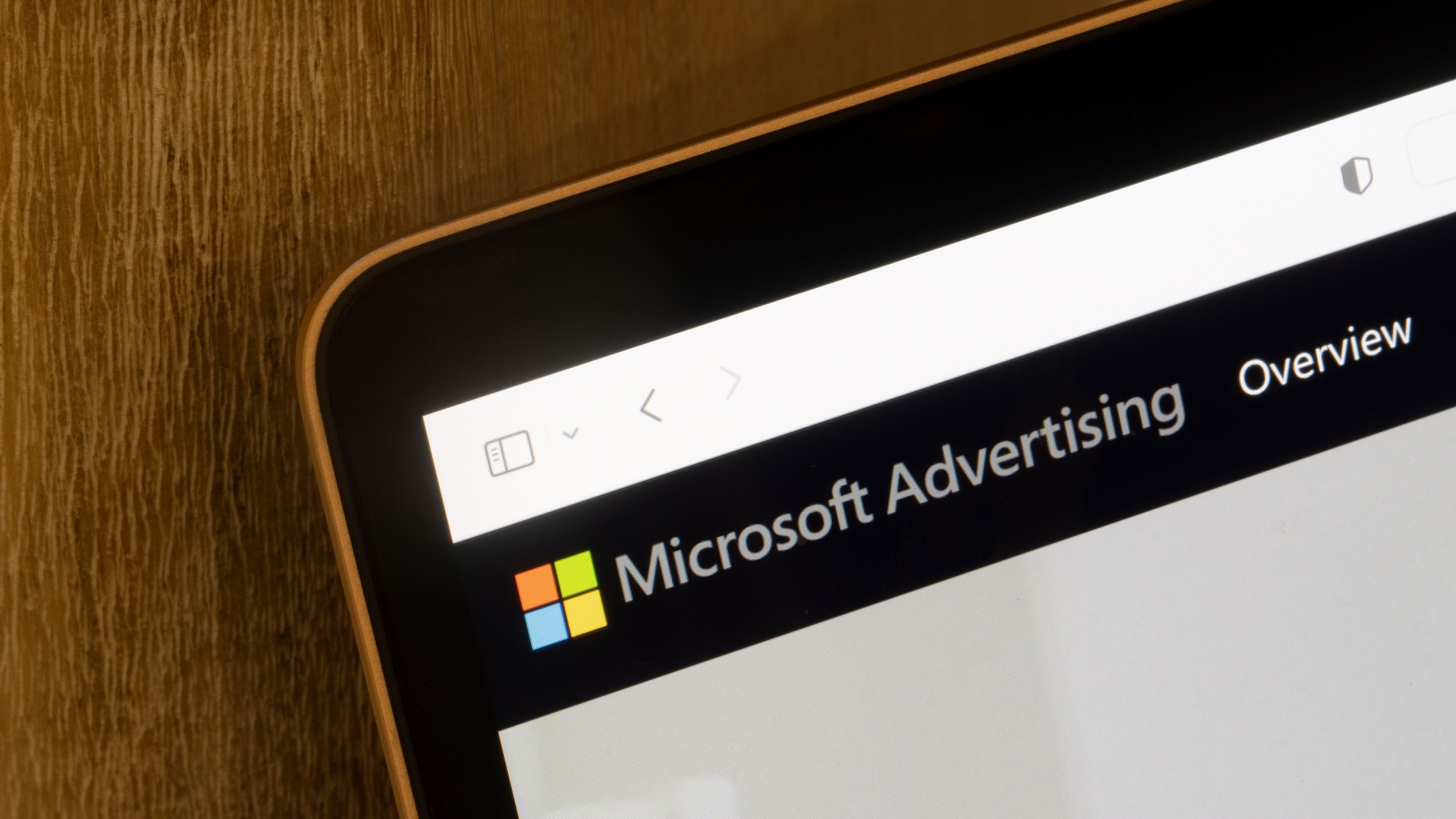
There’s a shift happening in digital advertising.
For years, remarketing hinged on clicks: someone had to visit your site, trigger a pixel, and leave behind a trail you could follow with ads.
But what if you could build your remarketing audience before they ever click?
That is the core promise of impression-based remarketing – a Microsoft Advertising-exclusive capability that lets advertisers build audiences (or exclusions) simply from users seeing their ads.
No click. No form fill. Just an impression.
In a world of privacy shifts, AI-driven search, and fractured attention spans, this approach may not just be a nice-to-have – it could be the future.
(Disclosure: I work as Microsoft’s product liaison, and the perspectives shared here reflect my role inside Microsoft Advertising.)
What is impression-based remarketing?
Impression-based remarketing is Microsoft Advertising’s super-powered audience targeting method.
Instead of waiting for a user to take an action such as visiting your site, it lets you track and segment audiences based solely on ad visibility.
Here is how it works in plain terms:
If your ad is displayed on Bing search results, native placements, Copilot, or other Microsoft inventory, the person who saw it can be added to a remarketing list.
That list can then be used for targeting, exclusions, or bid adjustments across eligible campaigns.
Key operational details:
- You can define up to 20 sources (campaigns or ad groups that feed your remarketing lists).
- The audience membership window can be 1-30 days (seven days is often the sweet spot for balancing awareness and consumer sentiment).
- Any campaign type can be a source, but not all can be a target. For example, Premium streaming can feed lists but cannot be targeted directly.
- Emerging surfaces like Copilot impressions are eligible as both sources and targets, though granular reporting is not yet fully available. To clarify, only Showroom ads (currently in closed beta) can specifically target Copilot placements.
- If you use autobidding, Microsoft’s system will factor in your bid adjustments, meaning a +20% bid really will raise CPC or CPM.
In short, it is the ability to remarket to people who have only seen your ad, which opens up a broader, top-of-funnel opportunity while respecting the growing limitations on tracking.
Dig deeper: Microsoft Advertising expands remarketing list sources to 20 campaigns
How to use it – functionally and strategically
Think of impression-based remarketing in two phases:
- Functional setup: The technical nuts and bolts.
- Strategic execution: Deciding which campaigns feed the lists, which campaigns target them, and what creative to use.
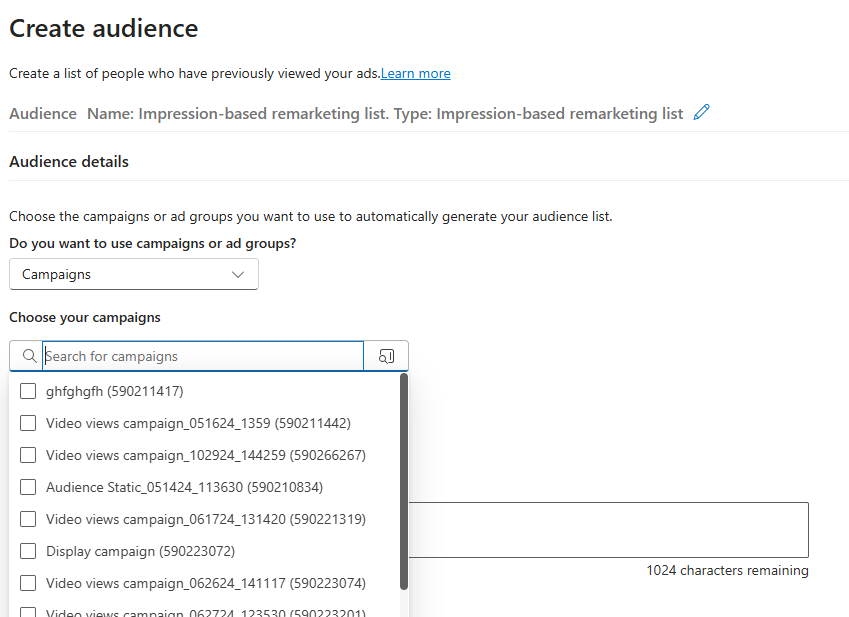
Functional setup
- Build your audience lists
- Identify the campaigns or ad groups that will act as sources.
- These are the ads whose impressions will populate your lists.
- Create associations
- Associate your sources with the target campaigns where you will use the audiences for targeting, exclusions, or bid adjustments.
- At least one audience ad must be in your associations to make all campaign types eligible to target.
- Decide on membership duration
- Seven days is often ideal to balance recency with volume, but your industry’s buying cycle may warrant shorter or longer windows.
- Layer on bid strategies
- Keep in mind that bid adjustments impact CPC or CPM directly under auto-bidding.
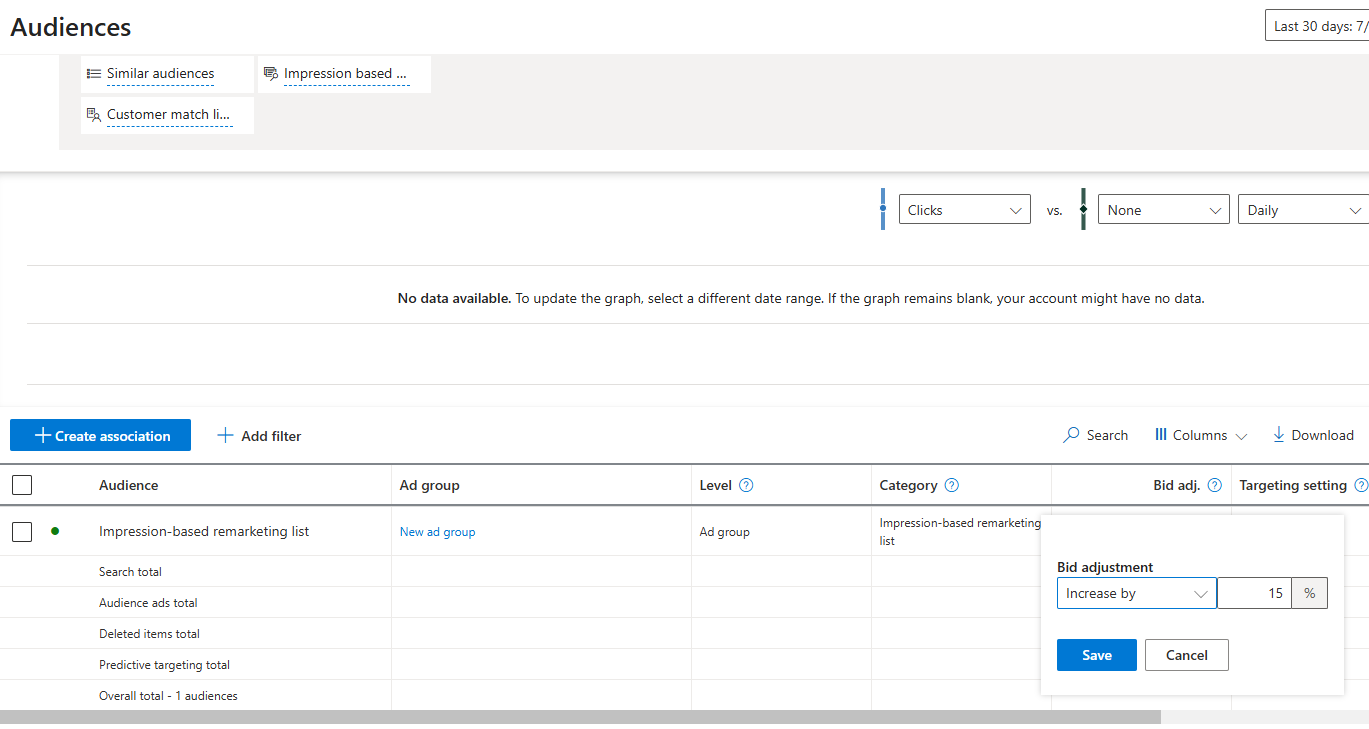
Strategic execution
This is where impression-based remarketing can go from “neat” to “needle-moving.”
Empathize with the customer journey
A first-time viewer is not ready for the same message as a warm lead.
The most common mistake in Impression-based remarketing is running the same creative to people regardless of where they are in the funnel.
For example:
- Cold audience (first exposure): Focus on brand awareness and curiosity hooks.
- Warm audience (saw an ad, maybe interacted with other brand assets): Lean into unique value propositions and proof points.
- Hot audience (familiar, showing intent signals): Shift toward urgency, offers, or clear conversion CTAs.
Tailor messaging to decision-makers vs. influencers
Not all buyers are the same. In B2B, especially, the person seeing your ad may not be the one signing the check.
- Decision-maker personas respond to concrete ROI, cost, terms, and support benefits.
- Influencer personas, those who need to convince the buyer, often respond better to emotional appeals, user stories, or tips on how to get leadership buy-in.
Use micro-steps in the buyer’s journey
Since the trigger is just an impression, do not assume you can skip stages.
Instead of expecting someone to leap from “saw ad” to “buy,” map out micro-conversions:
- Move from awareness to engagement (click, video view).
- From engagement to consideration (content download, add to cart).
- From consideration to decision (purchase, sign-up).
Sometimes this means setting ad groups, not just campaigns, as your sources and targets to allow for precise audience control.
Budget with conversion thresholds in mind
If your targeting is too narrow, you might never gather enough impressions to reach performance significance.
Budgets should align with the audience sizes needed to meet your conversion goals.
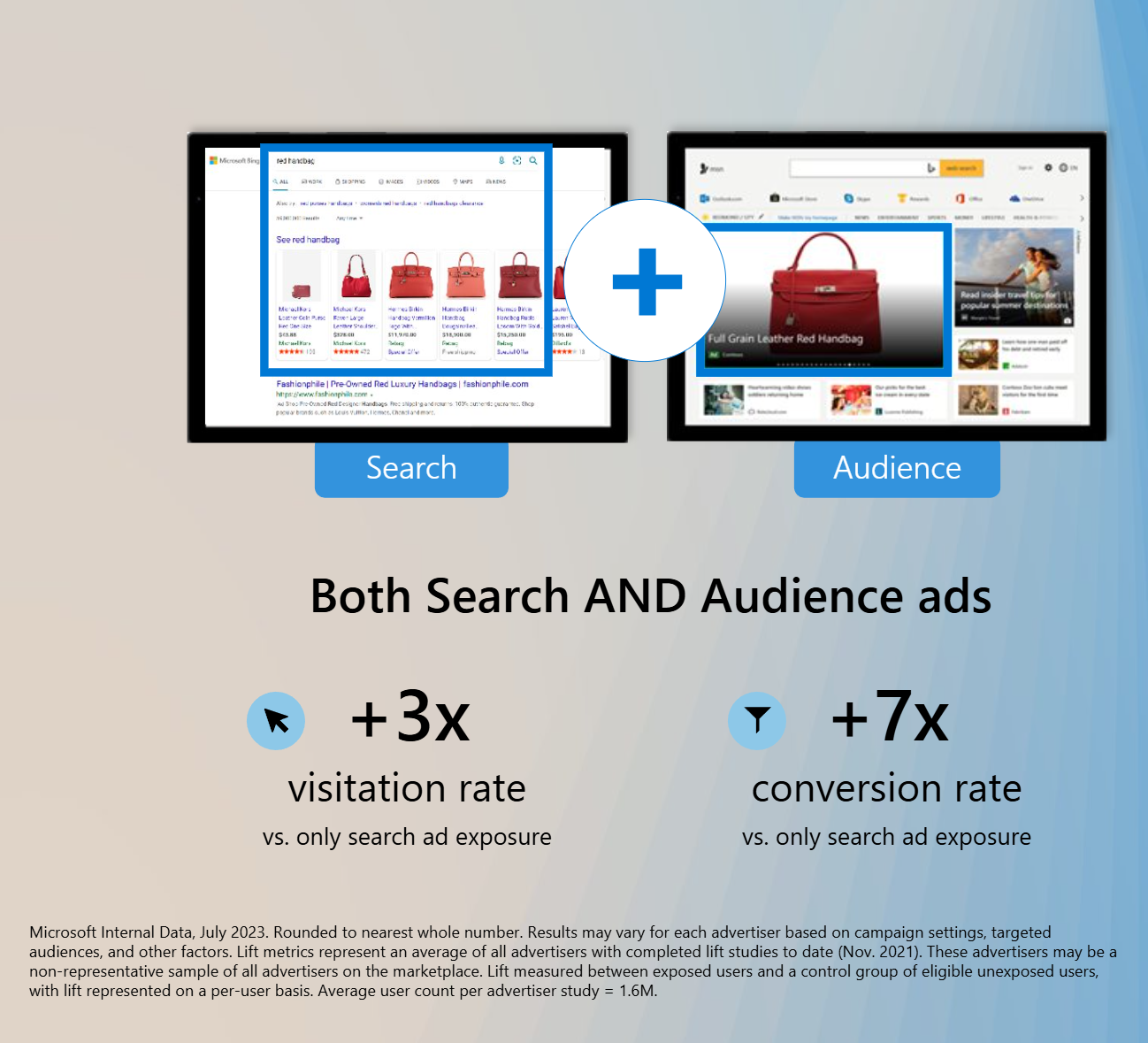
Get the newsletter search marketers rely on.
See terms.
Why impressions are the future
The shift to impression-based remarketing is not just about Microsoft offering a new targeting lever.
It’s about survival in a rapidly changing ecosystem.
1. Privacy is rewriting the rules
With cookie deprecation, consent restrictions, and stricter data privacy laws, the reliable, click-based remarketing audiences of the past are disappearing.
An impression, recorded server-side, does not rely on a user’s browser for tracking, making it a more resilient signal.
2. AI-powered search changes user behavior
As conversational AI like Microsoft Copilot, ChatGPT, and other assistants take center stage, the traditional search journey (“type query → click site → take action”) is being replaced.
In many cases, users will get answers without ever clicking a link.
This means advertisers must reach and influence people before they click, or even without them clicking at all.
Dig deeper: How Microsoft Ads compares to Google Ads and when to use it
3. Sentiment and recall become the new metrics
The old metrics, such as CTR, do not tell the whole story when much of the journey happens off-site.
The future winners will be brands that:
- Create memorable touchpoints.
- Build positive sentiment before a user enters the buying stage.
- Stay top-of-mind when the moment of need arises.
Impression-based remarketing allows you to intentionally re-engage based on visibility alone, which aligns perfectly with these goals.
4. Redeeming undervalued placements
Historically, advertisers have excluded certain placements, such as mobile games or sites with high ad density, because they seemed “low quality” in a click-through world.
Those same environments can be very effective for brand imprinting.
The user might not click in the moment, but repeated impressions in familiar contexts can drive recall later.
Impression-based remarketing allows you to capitalize on these “slow burn” touches without overvaluing accidental clicks.
Takeaways for advertisers
If you are planning campaigns for the holiday season or for the AI-driven world we are already stepping into, here is the checklist to make impression-based remarketing work for you:
- Set it up now
- Build your sources and associations.
- Keep the target list broad, but be selective with your sources.
- Map the journey
- Identify what someone needs to see first, second, and third.
- Create dedicated creative for each stage.
- Respect personas
- Decision-makers and influencers need different messaging.
- Avoid “one size fits all” creative blasts.
- Budget for volume and thresholds
- Without enough impressions, your targeting power fades.
- Ensure campaigns have enough spend to feed the machine.
- Think beyond clicks
- Use impression-based lists to drive brand familiarity, not just immediate conversions.
- Measure impact with recall and sentiment studies where possible.
Impression-based remarketing: From feature to future
Impression-based remarketing is not just another targeting option.
It is a structural shift in how advertisers can build relationships with their audiences.
In a clickless, AI-mediated future, it lets you control the who and when of your targeting, even if the how of user interaction changes completely.
Microsoft might have positioned it as a feature, but for savvy advertisers, it is a competitive moat.
Dig deeper: How to maximize your Google Ads remarketing campaigns


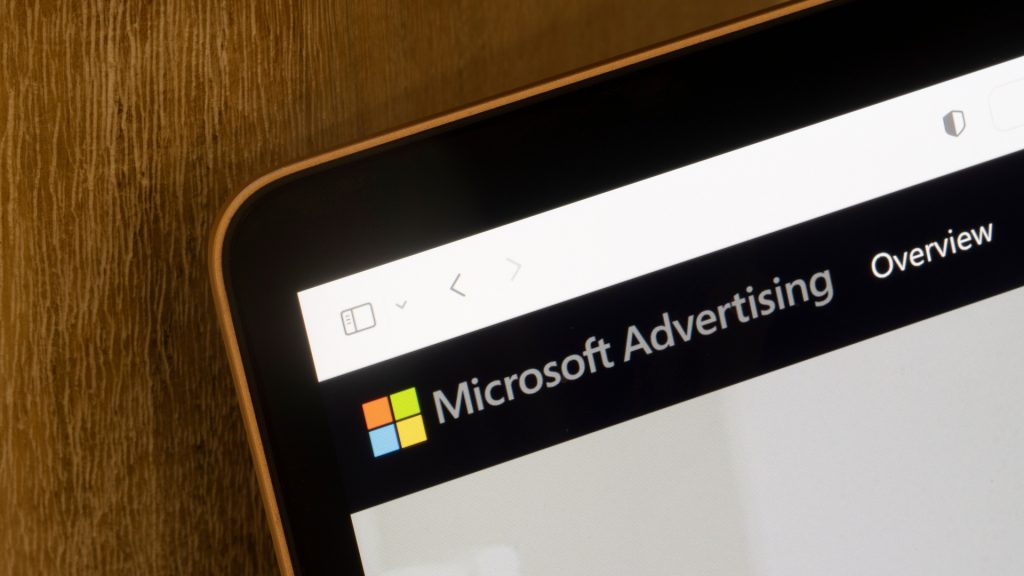




Recent Comments